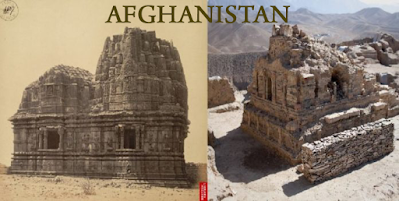AFGHANISTAN
By Steven Knapp
The word “Sthan” is actually a Sanskrit derivative that means place or land. There are a string of countries to the west of India with the suffix of “sthan,” including Baluchistan, Kurdistan, Siwisthan, Arvasthan, and Turgasthan (Turkey). Until the 10th century CE. Hindu kings ruled over Afghanistan, and thereafter still in parts of it. As mentioned in Albiruni’s India, compiled and edited by Dr. Edward D. Sachau, although Kabul had passed out of Hindu hands, the Hindu kings were still allowed to have their coronation ceremony in Kabul.
Many of the names in Afghanistan are also of Sanskrit origin. Pushtu, the language of Afghanistan, is replete with Sanskrit words. Kabul is also derived from the Sanskrit root Kubha. Temples of Mahanubhavas and other Indian sects are found in Kabul to this day. The Bamiyan valley of Afghanistan has several colossal statues of the Buddha carved out of the mountainsides as well as numerous rock-cut temples, similar to what we find in places of India such as Ellora and Ajanta. The name Jalalabad has been given to the town which earlier was known as Nagarhara; the town of Lord Shiva. This, along with the above information on Kabul, proves that all of the ancient palaces, forts, temples, mosques, and mansions that date back to the 9th century CE in Afghanistan were actually Vedic constructions, built by the Hindus, and the people were followers of the Vedic culture. The buildings that have since become mosques, or are now used for Islamic purposes, were captured during the invasions. Thus, it can be safe to say that it was not the Muslims who introduced the dome, lime, concrete, and the arch to India, but it was the Vedic Indians who introduced them to Persia. This is evidenced by the Muslim word “Gumbaj” for dome which comes from the Sanskrit word Kumbhaj, meaning the same thing.
In Some Blunders of Indian Historical Research (pages 244-6), Mr. Oak describes the early opulence of this area: “What is now Karachi was a famous Hindu city called Debal or Devalaya deriving its name from a lofty temple with a towering spire. Enclosed in rings of massive walls, this sacred site was repeatedly attacked during Mohammad Kasim’s times. King Dahir--whose real name is not known—ruled over that region when Mohammad Kasim started his invasion of India.
“According to Arab chronicles of Mohammad Kasim’s time, Sind, far from being a desert, teemed with lakes and forests and irrigated fields and gardens. It was only when the era of invasions started and these elaborate waterworks, as well as verdant fields, were repeatedly laid waste by marauding hordes that Sind and Baluchistan and Afghanistan became deserts… Until about the sixth century A.D., we find it mentioned in encyclopedias that Arabia too was a well-watered and vegetated land. But about 1,300 years ago the people in Middle-Western countries were seized by a new philosophy, a new way of life by which they organized themselves into raiding bands and raided neighboring countries to live off the toil of other people.
“The place where Akbar was born is called Umarkot. It is situated in Sind. Akbar’s father, Humayun, had sought the hospitality of a Hindu Rajput chief who ruled over Umarkot when Akbar was born. These instances should prove that Sind, Afghanistan, and Baluchistan were regions where Indian Kshatriyas ruled until 1,000 to 1,200 years ago and the people used to be all Hindus.”



Comments
Post a Comment